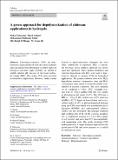A green approach for depolymerization of chitosan: applications in hydrogels
Author(s)
Tabassum, Nishat; Ahmed, Shoeb; Ittisaf, Mohammad M.; Rakid-Ul-Haque, Md.; Ali, M. A.
Download10570_2023_Article_5372.pdf (2.045Mb)
Publisher with Creative Commons License
Publisher with Creative Commons License
Creative Commons Attribution
Terms of use
Metadata
Show full item recordAbstract
Abstract
Chitooligosaccharides (COS) are depolymerized chains produced from the natural polymer chitosan and has been determined to exhibit improved biological activities, high solubility in neutral to slightly alkaline pH, because of the lower molecular weight (MW). This makes COS more attractive in biomedical applications. However, earlier studies focused on depolymerization techniques that were either cumbersome or expensive. Here, a convenient two-stage, green synthesis approach was developed and optimized, where gamma irradiation and oxidative degradation with H2O2 were used to depolymerize chitosan to produce COS for biomedical applications. The gamma radiation dose level, H2O2 degradation reaction’s temperature, time and H2O2 concentration were varied to obtain the mildest combination of reaction conditions. The most optimum set of conditions (15 kGy, 25oC, overnight reaction with 2% H2O2) yielded COS that was soluble in physiological pH range (7–8.5). The COS had a MW of 12.8 ± 1.6 kDa (which was a 95% reduction in MW), a 62.3% degree of deacetylation, and a crystallinity index of 33%. A photopolymerized hydrogel using this COS cross-linked with polyethylene glycol diacrylate (PEGDA) and carboxymethyl cellulose (CMC) was also developed. The hydrogel exhibited high swelling ratio (6.44–10.24), a porous morphology, a compression modulus of 4.5 ± 2.7 kPa (similar to soft tissues), and more than 95% biocompatibility with mammalian cells. This newly developed COS hydrogel involves a simple and green approach for the production of COS and shows promise as a scaffold for artificial soft tissue.
Date issued
2023-08-14Department
Massachusetts Institute of Technology. Department of Chemical EngineeringPublisher
Springer Netherlands
Citation
Tabassum, Nishat, Ahmed, Shoeb, Ittisaf, Mohammad M., Rakid-Ul-Haque, Md. and Ali, M. A. 2023. "A green approach for depolymerization of chitosan: applications in hydrogels."
Version: Final published version